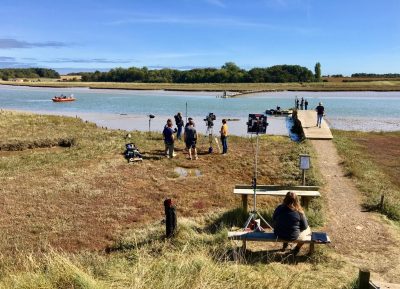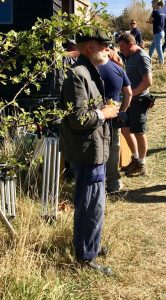Screen Suffolk are delighted to share this account of the filming that took place on The Butley Ferry. The scenes on the boat are so important in bringing Suffolk to life on screen.
Filming on the Butley River by Head Ferryman Roy Truman
For a few days in September 2019, the Butley River became the backdrop for scenes in a film being produced by Netflix of the novel “The Dig” by John Preston. The filming took place over just two days but was preceded by numerous visits by the director and members of the film crew as they planned the best views, the right tides and, of course, sought permission from the various land-owners. The beautiful landscape, which we are so used to, made such an impression on the director that a new storyline, and additional scenes which do not feature in the book, were written in to take full advantage of the scenery.

The book is set just prior to the second world war and is a dramatized account of the discovery of the Anglo-Saxon ship burial at Sutton Hoo by local archaeologist Basil Brown, played in the film by Ralph Feinnes. Mrs Pretty, the owner of the land where the discoveries were made, is played by Carey Mulligan. The book, and the film, take liberties for dramatic effect. Timelines are compressed, and details of the lives of the characters are changed. As the book was not a thesis, the film is not a documentary. It is entertainment based on fact. Butley Ferry stands in for the old Slaughden Ferry, which no longer exists. Boyton Dock, Shingle Street and Snape all feature whereas they do not appear in the book.
The scenes involving the ferry needed a ferryman and, because the director, Simon Stone, enjoyed the history of the ferry which he discovered on one of his visits, a ferryman’s wife was also written in. Real-life Butley ferrymen Stephen Worrall and Teresa Asslet were cast in those roles and, after visiting the costume and make-up department, were transported eighty years back in time to ferry Basil Brown across the river, and back. At one point during the filming, one of our local seals popped up to see what was going on. All action stopped as everyone watched. The cameraman filmed the visitor to possibly include it in the finished film.

Those simple scenes took a full day of filming. Anyone passing by, and many did as public footpaths were not closed, would have seen a small army of perhaps fifty people, their vehicles, tents and equipment, spread out below Burrow Hill, at the ferry. They all had to be fed and watered so a temporary canteen was also set up. Perhaps one of the most impressive aspects of this mini invasion was, that as soon as filming ended, they packed away and moved on within an hour. A small team of people replaced anything that had been moved, back to where it came from, cleared up any litter and left the site looking like they had not been there at all. The following morning, at low tide, the scenery crew removed the temporary staging from the jetties, put on to make our modern grating look more “period”.
There have been many instances when one or two thoughtless people can leave rubbish and cause damage out of all proportion to their numbers but, in the case of the film crew, they treated our river, landscape and its wildlife with respect and, as the saying goes, took only photographs, left only footprints.
